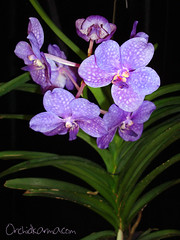 My lovely Ascocenda Princess Mikasa is blooming again. This is the blue color form, but it is actually really more purple than blue which suits me just fine. This is probably one of the most popular Vandaceous orchids in cultivation due to its showy large lowers, fairly compact size and willingness to bloom. The blue or pink color forms are quite common, but at the Gothenburg International Orchid Show a few weeks ago, German grower Karge displayed a new white color form of the Princess Mikasa called ‘Taynee White’. It is apparently produced using the alba color form of Vanda coerulea and should be available on the market by this spring. A friend of mine got a nice photo of it at the show.
My lovely Ascocenda Princess Mikasa is blooming again. This is the blue color form, but it is actually really more purple than blue which suits me just fine. This is probably one of the most popular Vandaceous orchids in cultivation due to its showy large lowers, fairly compact size and willingness to bloom. The blue or pink color forms are quite common, but at the Gothenburg International Orchid Show a few weeks ago, German grower Karge displayed a new white color form of the Princess Mikasa called ‘Taynee White’. It is apparently produced using the alba color form of Vanda coerulea and should be available on the market by this spring. A friend of mine got a nice photo of it at the show.
Ascocenda is actually a man-made hybrid genus and the result of a cross between Ascocentrum and Vanda. I don’t know of any orchids that inspire hybridizers more than the Vanda Alliance and the crosses can be quite complicated and yield stunning results. So, let’s work out the lineage behind Princess Mikasa, all 8 generations of them…! To help you keep this straight I am going to write this out properly, meaning that Genus is capitalized and italicized, species names are not capitalized but italicized, and Hybrid Names are capitalized and not italicized. Here we go.
Ascocenda Princess Mikasa = Ascocenda Royal Sapphire (seed parent) x Vanda coerulea (pollen parent). Ascocenda Royal Sapphire = Vanda Waianae Blue x Ascocenda Yip Sum Wah. Vanda Waianae Blue = Vanda Rothschildiana x Vanda Helen Paoa. Ascocenda Yip Sum Wah = Vanda Pukele x Ascocentrum curvifolium. Vanda Rothschildiana = Vanda coerulea x Euanthe sanderiana. Vanda Helen Paoa = Vanda Emily Notley x Euanthe sanderiana. Vanda Pukele = Vanda Betsy Sumner x Euanthe sanderiana. Vanda Emily Notley = Vanda Memoria T. Iwasaki x Vanda tessellata. Vanda Betsy Sumner = Vanda Faustii x Euanthe sanderiana. Vanda Memoria T. Iwasaki = Vanda dearei x Vanda tricolor. Vanda Faustii = Vanda Gilbert Triboulet x Vanda luzonica. Vanda Gilbert Triboulet = Vanda coerulea x Vanda tricolor.
There you have it. As we can see there is A LOT of Euanthe sanderiana in Princess Mikasa, but this is not that unusual as it is one of the most popular Vandaceous species in hybridization. We can also see that my Princess Mikasa gets its lovely blue color from Vanda coerulea. The famous blue orchid. This species is also a bit more cold growing, why Princess Mikasa is more tolerant to cooler temperatures, adding to its easy growing appeal. Interesting to note is that Euanthe sanderiana used to be included in the Vanda genus, but I really have no idea how the name change affects all the “Vanda” hybrids created using this species.
Oh, and this was the revised family tree… This info comes straight from The Royal Horticultural Society’s International Orchid Register. Nothing beats reliable sources… and good friends. Thanks for the correction Tommy!


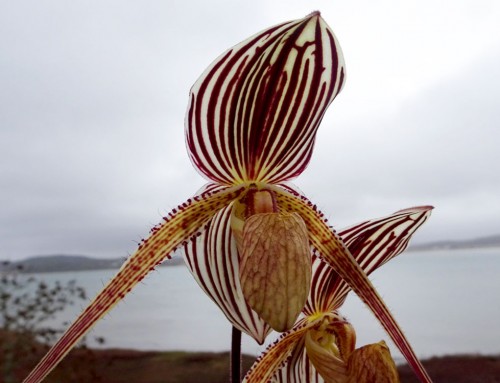
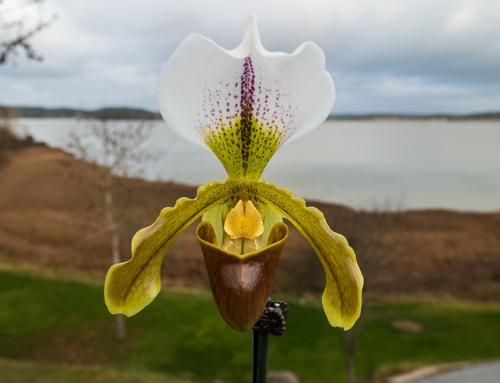
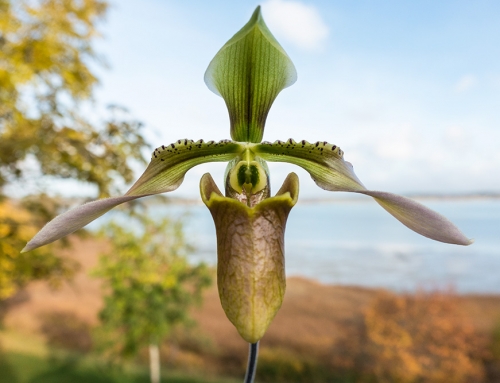
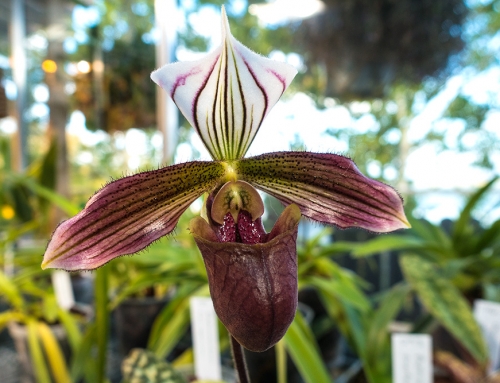

..this mourful colour is astonishing…
Thanks! 🙂 I know that I am partial to purple… but I agree, astonishing indeed!